Great discoveries in the digestive system.Diseases of digestive system презентация
Great discoveries in the digestive system.Diseases of digestive system презентация
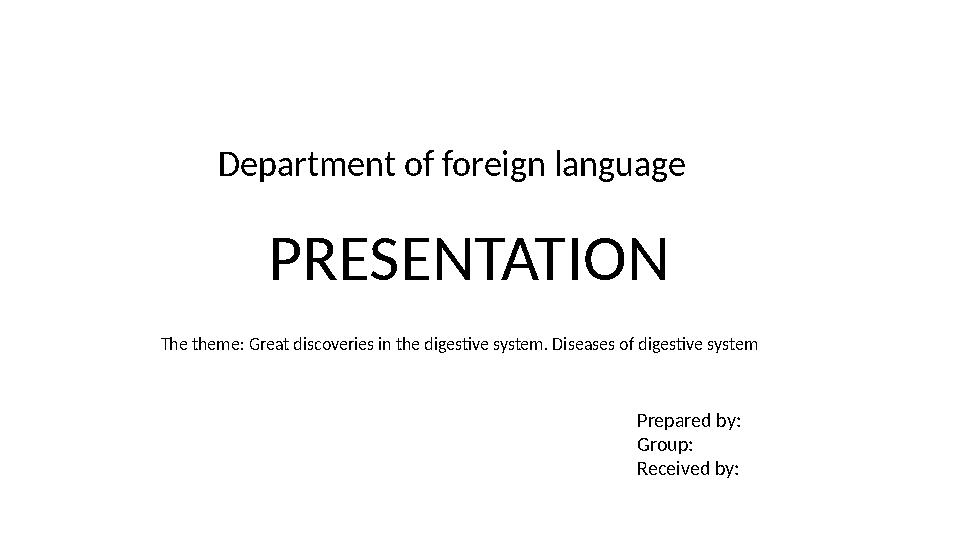

#1 слайд
Department of foreign language
PRESENTATION
The theme: Great discoveries in the digestive system. Diseases of digestive system
Prepared by:
Group:
Received by:
1 слайд
Department of foreign language PRESENTATION The theme: Great discoveries in the digestive system. Diseases of digestive system Prepared by: Group: Received by:
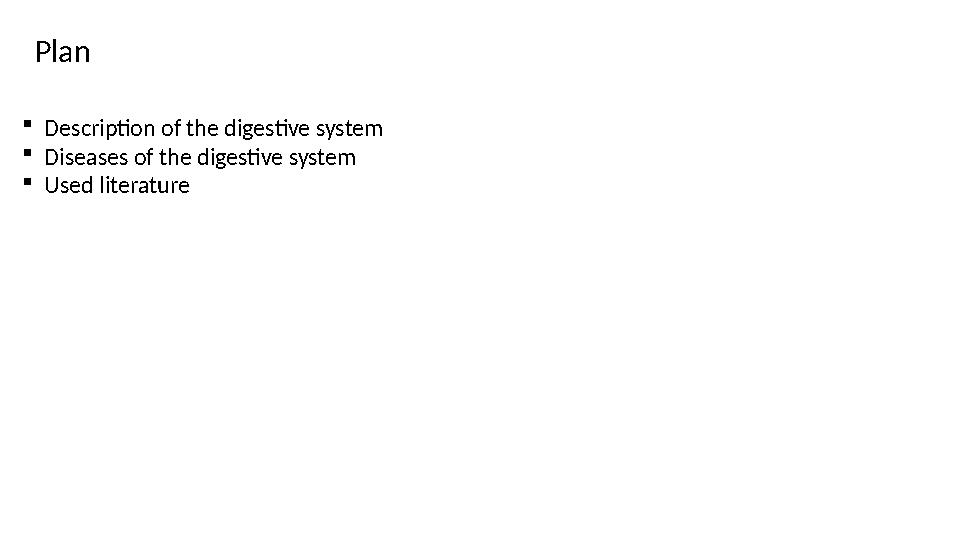
#2 слайд
Plan
Description of the digestive system
Diseases of the digestive system
Used literature
2 слайд
Plan Description of the digestive system Diseases of the digestive system Used literature
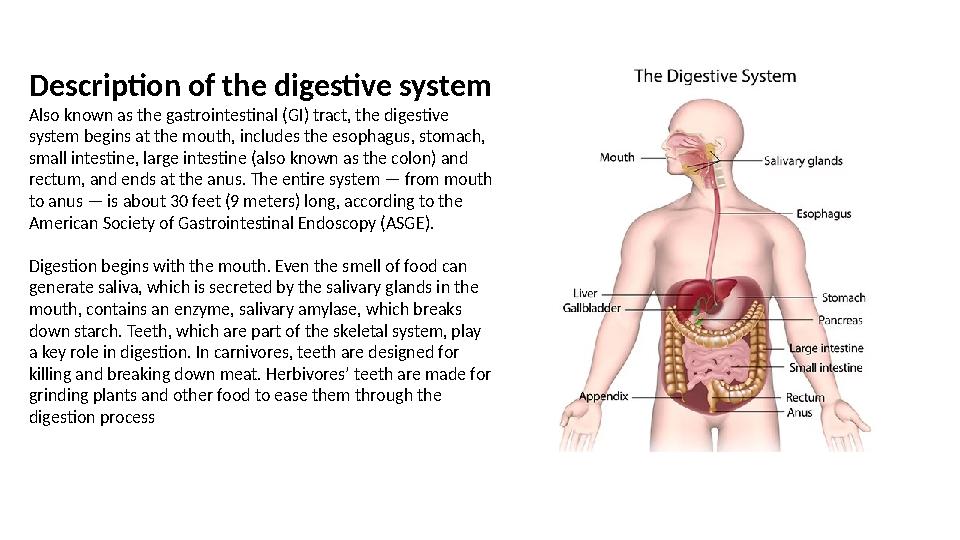
#3 слайд
Description of the digestive system
Also known as the gastrointestinal (GI) tract, the digestive
system begins at the mouth, includes the esophagus, stomach,
small intestine, large intestine (also known as the colon) and
rectum, and ends at the anus. The entire system — from mouth
to anus — is about 30 feet (9 meters) long, according to the
American Society of Gastrointestinal Endoscopy (ASGE).
Digestion begins with the mouth. Even the smell of food can
generate saliva, which is secreted by the salivary glands in the
mouth, contains an enzyme, salivary amylase, which breaks
down starch. Teeth, which are part of the skeletal system, play
a key role in digestion. In carnivores, teeth are designed for
killing and breaking down meat. Herbivores’ teeth are made for
grinding plants and other food to ease them through the
digestion process
3 слайд
Description of the digestive system Also known as the gastrointestinal (GI) tract, the digestive system begins at the mouth, includes the esophagus, stomach, small intestine, large intestine (also known as the colon) and rectum, and ends at the anus. The entire system — from mouth to anus — is about 30 feet (9 meters) long, according to the American Society of Gastrointestinal Endoscopy (ASGE). Digestion begins with the mouth. Even the smell of food can generate saliva, which is secreted by the salivary glands in the mouth, contains an enzyme, salivary amylase, which breaks down starch. Teeth, which are part of the skeletal system, play a key role in digestion. In carnivores, teeth are designed for killing and breaking down meat. Herbivores’ teeth are made for grinding plants and other food to ease them through the digestion process

#4 слайд
Swallowing pushes chewed food into the
esophagus, where it passes through the
oropharynx and hypopharynx. At this point, food
takes the form of a small round mass and
digestion becomes involuntary. A series of
muscular contractions, called peristalsis,
transports food through the rest of the system.
The esophagus empties into the stomach,
according to the National Institutes of Health
(NIH).
4 слайд
Swallowing pushes chewed food into the esophagus, where it passes through the oropharynx and hypopharynx. At this point, food takes the form of a small round mass and digestion becomes involuntary. A series of muscular contractions, called peristalsis, transports food through the rest of the system. The esophagus empties into the stomach, according to the National Institutes of Health (NIH).
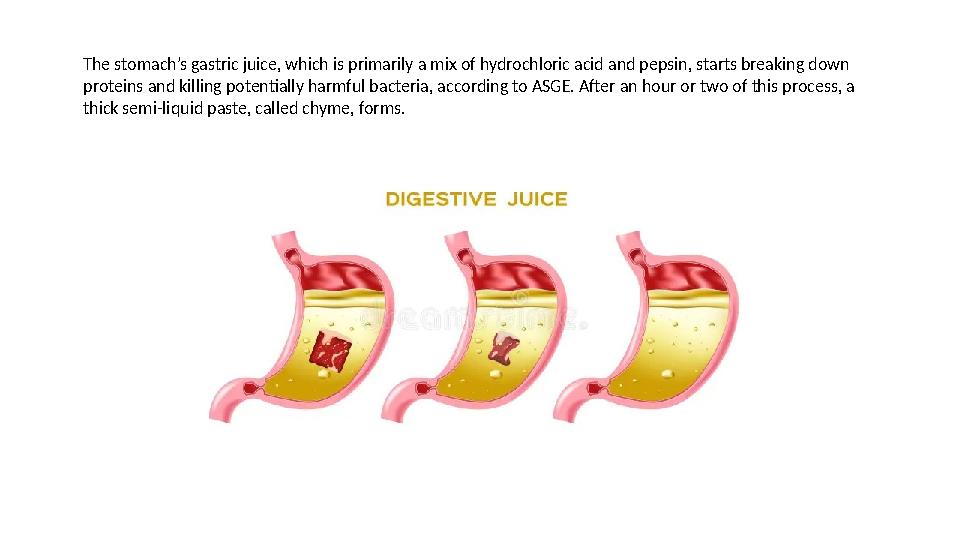
#5 слайд
The stomach’s gastric juice, which is primarily a mix of hydrochloric acid and pepsin, starts breaking down
proteins and killing potentially harmful bacteria, according to ASGE. After an hour or two of this process, a
thick semi-liquid paste, called chyme, forms.
5 слайд
The stomach’s gastric juice, which is primarily a mix of hydrochloric acid and pepsin, starts breaking down proteins and killing potentially harmful bacteria, according to ASGE. After an hour or two of this process, a thick semi-liquid paste, called chyme, forms.

#6 слайд
At this point the pyloric sphincter valve opens and
chyme enters the duodenum, where it mixes with
digestive enzymes from the pancreas and acidic bile
from the gall bladder, according to the Cleveland
Clinic. The next stop for the chyme is the small
intestine, a 20-foot (6-meter) tube-shaped organ,
where the majority of the absorption of nutrients
occurs. The nutrients move into the bloodstream and
are transported to the liver.
6 слайд
At this point the pyloric sphincter valve opens and chyme enters the duodenum, where it mixes with digestive enzymes from the pancreas and acidic bile from the gall bladder, according to the Cleveland Clinic. The next stop for the chyme is the small intestine, a 20-foot (6-meter) tube-shaped organ, where the majority of the absorption of nutrients occurs. The nutrients move into the bloodstream and are transported to the liver.

#7 слайд
The liver creates glycogen from sugars and
carbohydrates to give the body energy and converts
dietary proteins into new proteins needed by the
blood system. The liver also breaks down unwanted
chemicals, such as alcohol, which is detoxified and
passed from the body as waste, the Cleveland Clinic
noted.
7 слайд
The liver creates glycogen from sugars and carbohydrates to give the body energy and converts dietary proteins into new proteins needed by the blood system. The liver also breaks down unwanted chemicals, such as alcohol, which is detoxified and passed from the body as waste, the Cleveland Clinic noted.

#8 слайд
Whatever material is left goes into the large intestine. The
function of the large intestine, which is about 5 feet long (1.5
meters), is primarily for storage and fermentation of
indigestible matter. Also called the colon, it has four parts: the
ascending colon, the transverse colon, the descending colon
and the sigmoid colon. This is where water from the chyme is
absorbed back into the body and feces are formed primarily
from water (75 percent), dietary fiber and other waste
products, according to the Cleveland Clinic. Feces are stored
here until they are eliminated from the body through
defecation.
8 слайд
Whatever material is left goes into the large intestine. The function of the large intestine, which is about 5 feet long (1.5 meters), is primarily for storage and fermentation of indigestible matter. Also called the colon, it has four parts: the ascending colon, the transverse colon, the descending colon and the sigmoid colon. This is where water from the chyme is absorbed back into the body and feces are formed primarily from water (75 percent), dietary fiber and other waste products, according to the Cleveland Clinic. Feces are stored here until they are eliminated from the body through defecation.
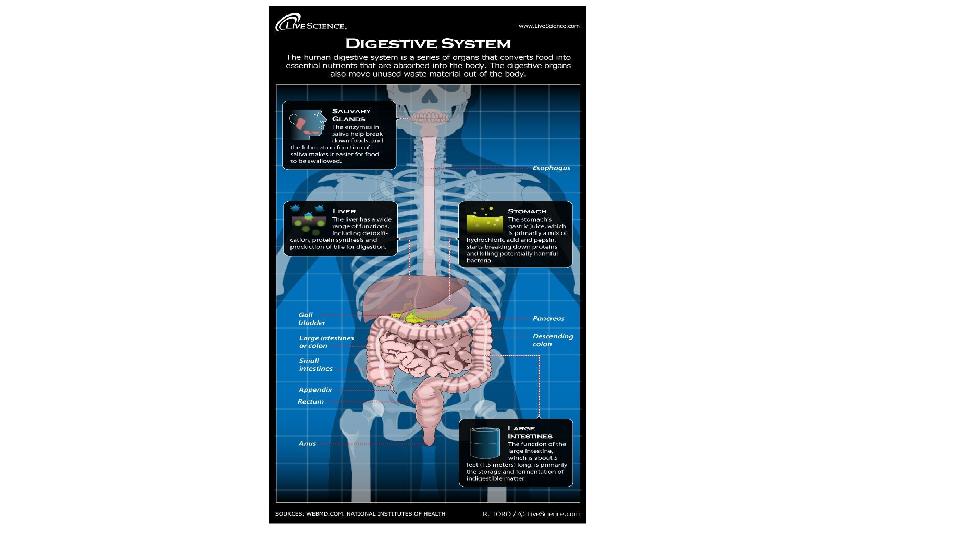
#9 слайд
9 слайд
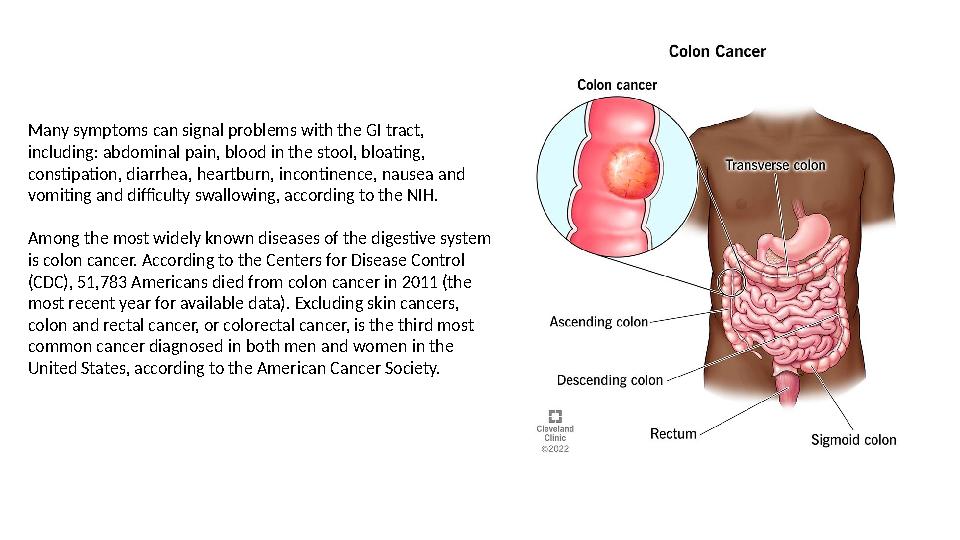
#10 слайд
Many symptoms can signal problems with the GI tract,
including: abdominal pain, blood in the stool, bloating,
constipation, diarrhea, heartburn, incontinence, nausea and
vomiting and difficulty swallowing, according to the NIH.
Among the most widely known diseases of the digestive system
is colon cancer. According to the Centers for Disease Control
(CDC), 51,783 Americans died from colon cancer in 2011 (the
most recent year for available data). Excluding skin cancers,
colon and rectal cancer, or colorectal cancer, is the third most
common cancer diagnosed in both men and women in the
United States, according to the American Cancer Society.
10 слайд
Many symptoms can signal problems with the GI tract, including: abdominal pain, blood in the stool, bloating, constipation, diarrhea, heartburn, incontinence, nausea and vomiting and difficulty swallowing, according to the NIH. Among the most widely known diseases of the digestive system is colon cancer. According to the Centers for Disease Control (CDC), 51,783 Americans died from colon cancer in 2011 (the most recent year for available data). Excluding skin cancers, colon and rectal cancer, or colorectal cancer, is the third most common cancer diagnosed in both men and women in the United States, according to the American Cancer Society.
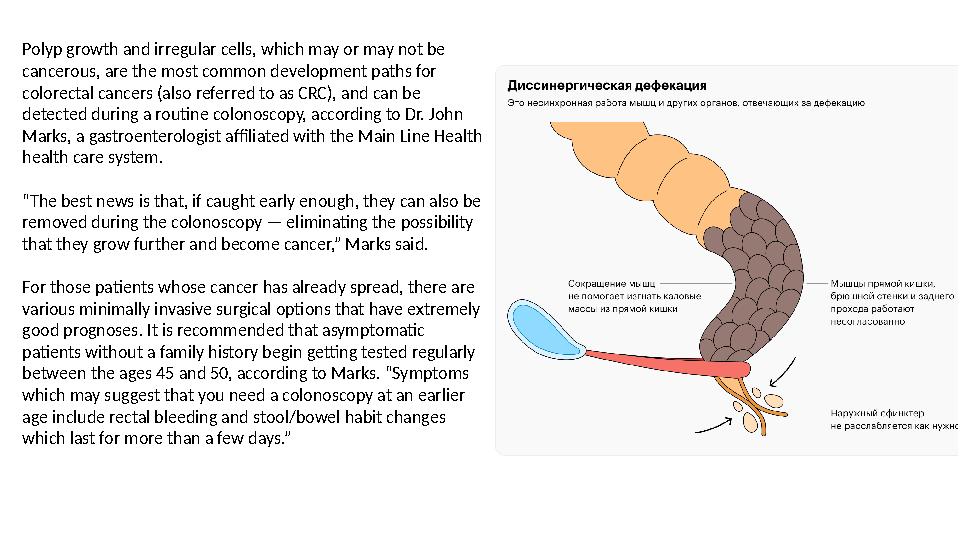
#11 слайд
Polyp growth and irregular cells, which may or may not be
cancerous, are the most common development paths for
colorectal cancers (also referred to as CRC), and can be
detected during a routine colonoscopy, according to Dr. John
Marks, a gastroenterologist affiliated with the Main Line Health
health care system.
“ The best news is that, if caught early enough, they can also be
removed during the colonoscopy — eliminating the possibility
that they grow further and become cancer,” Marks said.
For those patients whose cancer has already spread, there are
various minimally invasive surgical options that have extremely
good prognoses. It is recommended that asymptomatic
patients without a family history begin getting tested regularly
between the ages 45 and 50, according to Marks. “Symptoms
which may suggest that you need a colonoscopy at an earlier
age include rectal bleeding and stool/bowel habit changes
which last for more than a few days.”
11 слайд
Polyp growth and irregular cells, which may or may not be cancerous, are the most common development paths for colorectal cancers (also referred to as CRC), and can be detected during a routine colonoscopy, according to Dr. John Marks, a gastroenterologist affiliated with the Main Line Health health care system. “ The best news is that, if caught early enough, they can also be removed during the colonoscopy — eliminating the possibility that they grow further and become cancer,” Marks said. For those patients whose cancer has already spread, there are various minimally invasive surgical options that have extremely good prognoses. It is recommended that asymptomatic patients without a family history begin getting tested regularly between the ages 45 and 50, according to Marks. “Symptoms which may suggest that you need a colonoscopy at an earlier age include rectal bleeding and stool/bowel habit changes which last for more than a few days.”
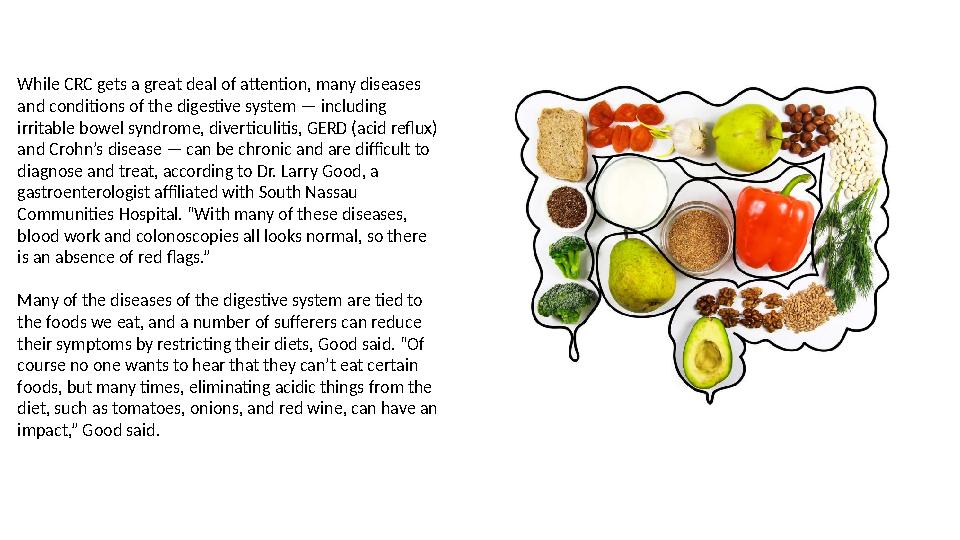
#12 слайд
While CRC gets a great deal of attention, many diseases
and conditions of the digestive system — including
irritable bowel syndrome, diverticulitis, GERD (acid reflux)
and Crohn’s disease — can be chronic and are difficult to
diagnose and treat, according to Dr. Larry Good, a
gastroenterologist affiliated with South Nassau
Communities Hospital. “With many of these diseases,
blood work and colonoscopies all looks normal, so there
is an absence of red flags.”
Many of the diseases of the digestive system are tied to
the foods we eat, and a number of sufferers can reduce
their symptoms by restricting their diets, Good said. “Of
course no one wants to hear that they can’t eat certain
foods, but many times, eliminating acidic things from the
diet, such as tomatoes, onions, and red wine, can have an
impact,” Good said.
12 слайд
While CRC gets a great deal of attention, many diseases and conditions of the digestive system — including irritable bowel syndrome, diverticulitis, GERD (acid reflux) and Crohn’s disease — can be chronic and are difficult to diagnose and treat, according to Dr. Larry Good, a gastroenterologist affiliated with South Nassau Communities Hospital. “With many of these diseases, blood work and colonoscopies all looks normal, so there is an absence of red flags.” Many of the diseases of the digestive system are tied to the foods we eat, and a number of sufferers can reduce their symptoms by restricting their diets, Good said. “Of course no one wants to hear that they can’t eat certain foods, but many times, eliminating acidic things from the diet, such as tomatoes, onions, and red wine, can have an impact,” Good said.
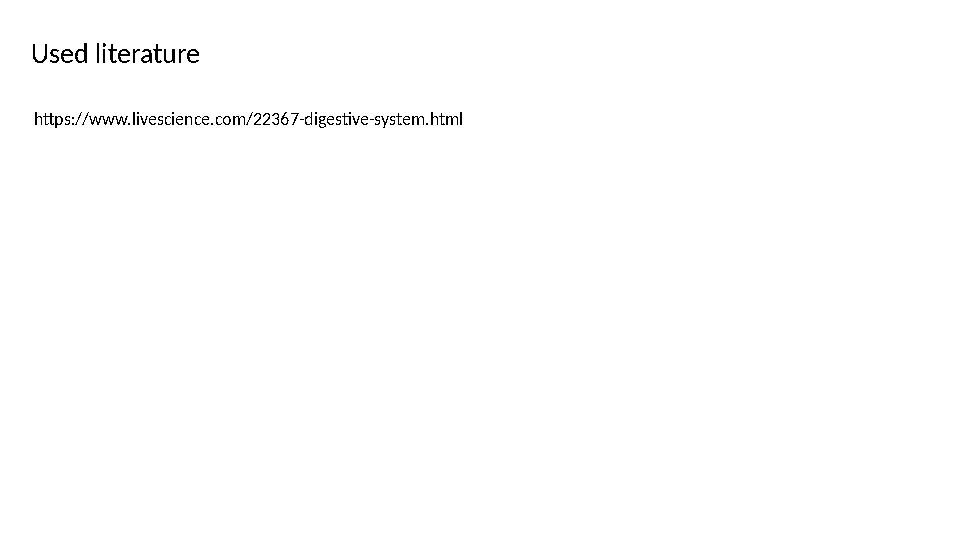
#13 слайд
Used literature
https://www.livescience.com/22367-digestive-system.html
13 слайд
Used literature https://www.livescience.com/22367-digestive-system.html

шағым қалдыра аласыз
















